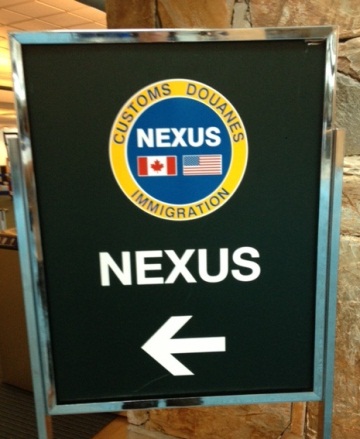Serendipity and the Nexus
I’m often asked how we settled on using the term “the nexus” for a concept that is defining some of the National Center’s work. More than a few people have shared with me that there are other successful programs, and even hair products, that use the term. I can truly say that whatever one thinks of it, the word “nexus” does make people stop and think…including me recently. I’m finding the “nexus” everywhere, filled with symbolism, and I think it’s more than coincidence.
 Last month the National Center staff who attended the Collaborating Across Borders (CAB) IV conference in Vancouver couldn’t help but laugh as these signs welcomed us to Canada. For the past several months we’ve been intensely focused on the Nexus in our own work and, suddenly, it’s an international trend.
Last month the National Center staff who attended the Collaborating Across Borders (CAB) IV conference in Vancouver couldn’t help but laugh as these signs welcomed us to Canada. For the past several months we’ve been intensely focused on the Nexus in our own work and, suddenly, it’s an international trend.
The U.S. – Canadian nexus is about making entry between the two countries easier. When I arrived at the Vancouver airport, the attempt to improve the process of travel between the two countries was clearly visible. On the way home, after going through the new nexus procedures, I entered an area of the YVR airport with a sign that said “You are entering the United States” on Canadian soil. I simply walked off the plane as usual in the Minneapolis-St. Paul airport. Customs had already been handled in the designated U.S. area in Canada.
Since 2001—like it or not—new laws, regulations, and paperwork had made the old, simpler ways more cumbersome and complex, sometimes getting in the way of a friendly relationship. While I’m certain each regulation and process had a reason, new protections and concerns replaced seamless travel between our two countries, making it more difficult to work together.
Today, each country is working to adapt and thrive within its own borders and globally. Some goals are the same; some are different. Simple solutions cannot address such complex problems. Despite that complexity, the U.S. – Canadian nexus communicates a willingness to create a functional and innovative way of working together while meeting the individual needs of each country.
That’s the “Nexus” concept we are adopting for the National Center. Health systems and health professions schools are evolving rapidly and navigating through ambiguity. They are incorporating new ways of thinking and responding to emerging demands within their own systems. At the National Center, we see innovation and opportunity in these challenges. With so much confusion in today’s health care environment, we must strive to reconnect the disparate pieces of our complex systems. The Josiah Macy Jr. Foundation recently released conference proceedings that explore the concept of the Nexus, including relevant case studies and recommendations. I encourage you to take a look at this report.
Is the proliferation of the nexus concept just coincidence? I don’t think so. I believe there is a reason more than a few organizations are using this term. For example, check out the NEXus project in nursing education. This is great example of how the Nexus describes the kind of connection, partnership and shared responsibility for progress that we need today.
 Finally, I have to share one more serendipitous moment from my recent trip to Vancouver. A colleague at CAB IV referred me to a nearby art gallery, telling me I must purchase this pair of earrings with a design that the artist had named “Nexus” based on a Canadian First Nations legend. But that’s another story for another day.
Finally, I have to share one more serendipitous moment from my recent trip to Vancouver. A colleague at CAB IV referred me to a nearby art gallery, telling me I must purchase this pair of earrings with a design that the artist had named “Nexus” based on a Canadian First Nations legend. But that’s another story for another day.
I’ll be exploring these issues more deeply in my next few blogs and in papers I am now writing with colleagues. We are working through our meaning of the Nexus, and we need your help to tell the story. Tell us what the Nexus means to you. Where have you seen the concept of a “nexus” in your own experiences? What are the opportunities to reconnect health professions education and the transformation of care delivery in your own organizations?


Join the Conversation
Every registered user can comment on website content.
Please login or register to comment